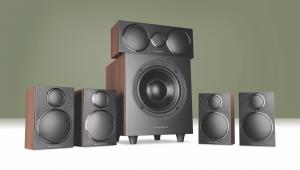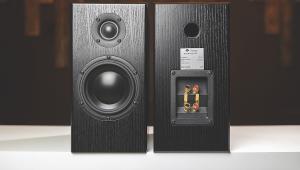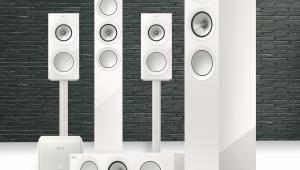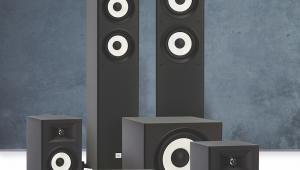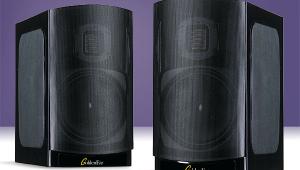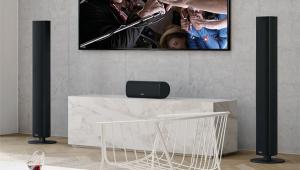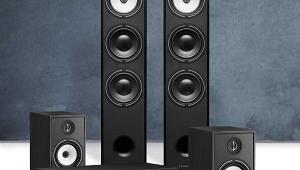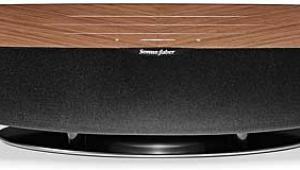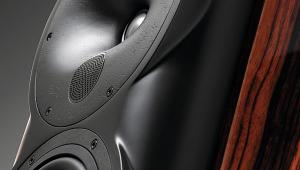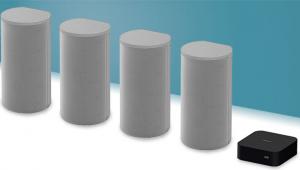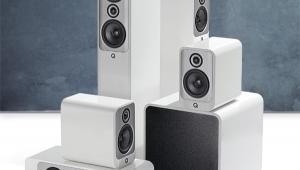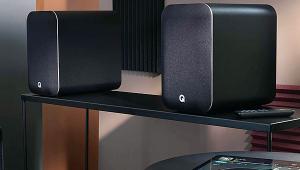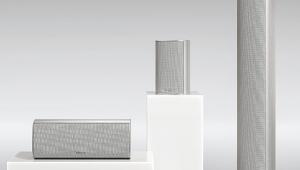JBL Studio 2 5.1 speaker system review
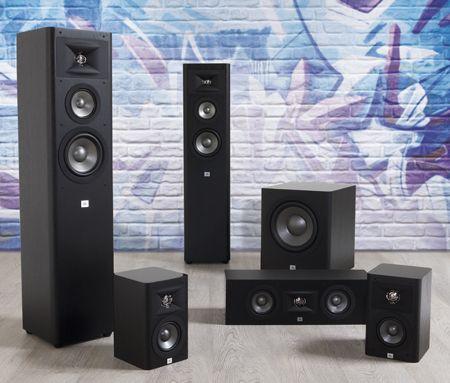
 The public perception of a brand is a curious thing. JBL is one of the most venerable outfits in the market and has an extensive range, including lush high-end models such as the Everest flagship. Yet in the UK it has a rather low profile, one that is largely influenced by its compact speakers and desktop audio biz.
The public perception of a brand is a curious thing. JBL is one of the most venerable outfits in the market and has an extensive range, including lush high-end models such as the Everest flagship. Yet in the UK it has a rather low profile, one that is largely influenced by its compact speakers and desktop audio biz.
This often means that the full-size speakers that JBL offers can sneak under the radar, which is a shame when the specifications of the Studio 2 series are considered.
This seven-strong range of standmounts, floorstanders, centres and subwoofers looks to provide a considerable amount of speaker for your money. It also manages to include one of JBL’s most distinctive pieces of in-house technology. All Studio 2 speakers feature a 1in, horn-loaded HDI tweeter, derived from the design used in much more expensive models. The benefits of mounting a tweeter in this way, says JBL, is improved dispersion and off-axis response over a conventional dome design. It can often lead to increased sensitivity, too – although in the case of the Studio 220 bookshelves in particular (which claim a sensitivity of 86dB) they don’t appear to be any more easily-driven than the competition.
These tweeters are partnered with ‘Poly Plas’ (plastic) drivers and here, again, the JBLs are a distinctive design. The floorstanding Studio 270 makes use of a 6.5in unit, as is typical of a speaker at this price point, but proceeds to partner it with a 4in midrange driver that makes the 270 a genuine three-way offering. The presence of this 4in driver is also helpful in terms of integration with the Studio 220 surround and 225C Centre, which only employ this 4in cone (larger versions of both with 6.5in drivers are also available) and the HDI tweeter.
The SUB 250P woofer is perhaps the most conventional member of the family. It features a 10in version of the Poly Plas driver, powered by a 200W Class D amplifier. Connections and controls are pretty much what you'd expect at the bargain price, save for the SUB 250P having to make do without a dedicated LFE input. Like the rest of the range, the sub is rear- ported – in this case with an absolute whopper – but in use it doesn’t seem to be that intrusive in terms of placement near to walls.
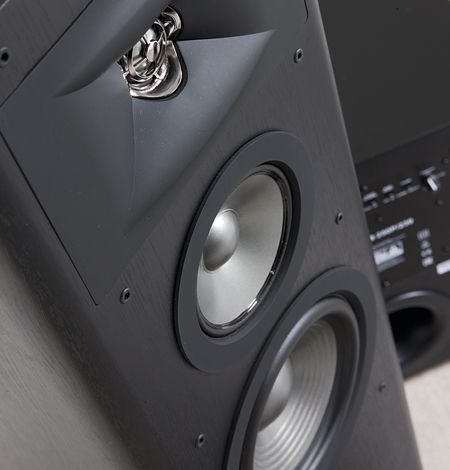
The appearance of the JBLs might be politely described as functional and less charitably as ugly. The black finish of our review samples doesn’t really make for a desperately attractive speaker, even though there are a few touches towards styling such as the rounded cabinet edges and gloss finished tops. The JBLs look fairly austere without their grilles and somewhat monolithic with them on. The 225C centre is a particularly unfortunate-looking thing as it doesn’t feature the rounded edge at the front that the other speakers do, and JBL in its infinite wisdom has decided to gloss the ends rather than the actual top of the cabinet. You can get all these speakers in a wood finish but I don’t think they're are ever going to be considered furniture.
While they aren’t pretty they are all fairly substantial in terms of build and finish. Everything seems carefully assembled and there are some pleasing additions, like the rubber feet that can be fitted with spikes and the protective guards for the tweeters.
Setup proved simple enough. Although all the speakers are rear-ported, none of them seemed too concerned by proximity to a wall and best results were gained with no toe-in on the front speakers and the SUB 250P kept on-axis at the front. Connected to a Pioneer SC-LX57 AV receiver, the JBLs didn't throw up any unwelcome surprises during auto setup and seemed happiest with a 50Hz crossover for the 270s and 80Hz for the centre and surround channels.
Simple installation completed, they begin to show some impressive attributes. With the same tweeter and 4in driver present across all five speakers, the integration between them is extremely convincing. Those neat horn-loaded tweeters do indeed seem to have really excellent dispersion and this makes for a wide and extremely even front soundstage. Furthermore, there is precious little sign of harshness or aggression, even with the output on the Pioneer turned up high. The Studios power their way through Wreck-It Ralph with a real sense of the layered and lavish soundstage that brings the movie's Sugar Rush scenes to life.
Further listening suggests that the decision to use this 4in midrange driver with the tweeter pays dividends in terms of detail and smoothness, because the JBLs are operating efficiently at a frequency point where many rivals are having to think about effecting a crossover. Coupled with the tweeter, the result is immersive dialogue and excellent fine detail retrieval. These are attributes equally useful to music reproduction, and in both stereo and 5.1 the JBLs are consistently capable.
Further down the frequency response, the Studios are a little less assured. The bass response of the Studio 270 is fairly deep but slightly soft and the SUB 250P seems to be similar. During the two-hour bass-fest of Pacific Rim, the JBLs never seem to lack absolute level but there is a softness to the robot-on-monster action that dulls some of the impact. The news isn’t all bad, though, as while it might be fractionally soft, the SUB 250P isn’t something you could accuse of being slow or bloated. Whatever lack of absolute slam it might suffer from, it remains impressively controlled even when provoked.
This means that if you don’t exist solely on a diet of explosions, the JBLs are capable of a scale and presence that can elude speakers at this price point, particularly smaller designs. The marvellously atmospheric score to Rush is handled with an assurance that is beyond many competitors and any broadcast TV that benefits from an expansive and detailed performance is treated to this in no uncertain terms. The Studios also manage to retain most of their talents at lower volumes – useful for anyone looking to use their speakers all the time and not simply for movie night.
Accomplished all-roundersTaken as a whole, this is a very accomplished and appealing speaker package on many levels. JBL’s experience with its horn-loaded tweeter and the unusual decision to make the affordable Studio 2 a three-way design has resulted in an array that sounds big, smooth and civilised with a wide variety of material. The slight softness to the bass response might put off full-on action fans but people with wider tastes will enjoy the spread of ability that this system possess.
The only real fly in the ointment is that this ability comes in such a utilitarian container. There is no escaping that the Studios have to concede ground to rivals in this area, although as ever, beauty is in the eye of the beholder. And I would argue that the just-over-a-grand asking price counters this. There aren't many options for floorstanders on this budget, and you shouldn't expect them to look like they've come straight from a Milan catwalk.
Specification
Studio 270 floorstanders
Drive units: 1 x 6.5in Poly Plas bass driver; 1 x 4in Poly Plas mid-range driver; 1 x 1in horn-loaded HDI tweeter
Enclosure: Ported
Frequency response: 45Hz-22kHz
Sensitivity: 88dB
Power handling: 200W
Dimensions: 1,010(h) x 237(w) x 244(d)mm
Weight: 16.1kg
Studio 220 surrounds
Drive units: 1 x 4in Poly Plas mid/bass driver and 1 x 1in horn-loaded HDI tweeter
Enclosure: Ported
Frequency response: 60Hz-22kHz
Sensitivity: 86dB
Power handling: 120W
Dimensions: 260(h) x 237(w) x 180(d)mm
Weight: 3.7kg
Studio 225C centre
Drive units: 2 x 4in Poly Plas mid/bass drivers; 1 x 1in horn-loaded HDI tweeter
Enclosure: Ported
Frequency response: 60Hz-22kHz
Sensitivity: 88dB
Power handling: 120w
Dimensions: 165(h) x 535(w) x 187(d)mm
Weight: 7.9kg
SUB 250P subwoofer
Drive units: 10in Poly Plas woofer
Enclosure: Ported
Frequency response: 32-150Hz
On board power: 200W
Remote control: No
Dimensions: 419(h) x 341(w) x 389(d)mm
Weight: 15.kg
Connections: Left and right line-level input
 |
Home Cinema Choice #351 is on sale now, featuring: Samsung S95D flagship OLED TV; Ascendo loudspeakers; Pioneer VSA-LX805 AV receiver; UST projector roundup; 2024’s summer movies; Conan 4K; and more
|




